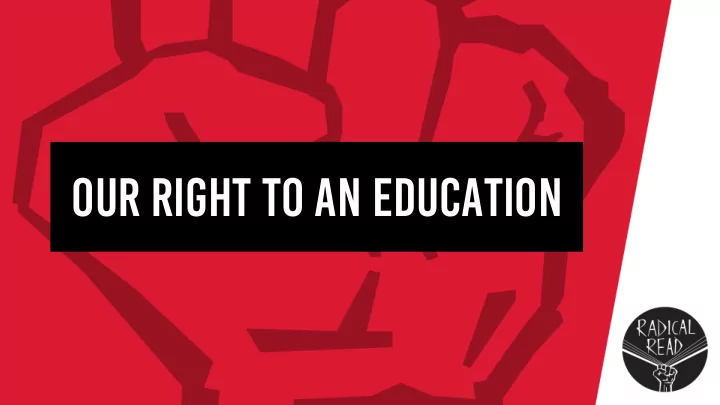

Our right to an education
Learning Objectives Think about the value of education, and the different important • ways it can affect us. Learn about the different groups of people who have been • denied an access to education, both historically and today. Find out about Malala Yousafzai, her life, and her work to • promote women’s access to education. Discover how Latin American students tried to ensure that poor • people had access to education in the early twentieth century.
MALALA yOUSAFZAI Malala Yousafzai is a young Muslim woman. Born in Pakistan, in 1997. (Simon Davis/DFID)
She lived in an area called Swat, in Pakistan. When she was young a group called the Taliban controlled this region. www.dw.com/en/women-defy-local-traditions-in-pakistans-swat-valley/a-38609291
The Taliban believe that women should not be allowed out in public or near men who they are not related to. When they were in control they tried to stop girls from attending school, using violence to keep them away. Education was important to Malala and her family. Her father, Ziauddin Yousafzai, ran several schools which were open to both boys and girls. Malala believes that Islam encourages education for all. Taylor Jones/El Nuevo Dia
Malala continued to attend school in secret. She wrote an anonymous blog for the BBC Urdu service about her experiences. Her father spoke out against the closure of girls’ schools by the Taliban, and was threatened by them. Malala decided she should speak out publicly about the importance of education for girls. She appeared on television and radio, and became famous in Pakistan for her activism. She planned to set up the Malala Education Foundation, which would help poor girls go to school. Pat Bagley, Salt Lake Tribune
The Taliban decided that she was a threat to their ideas. In October, 2012, after completing an exam, she was shot in the head by a Taliban gunman while on the bus home. She was 15 years old.
Malala survived the attack, and went to the UK for surgery and to recover from her injuries. The Taliban did not silence Malala. She has become more famous since the attack- she spoke at the United Nations, became the youngest person to ever receive the Nobel Peace Prize, wrote several books, and set up the Malala Fund. The Malala Fund helps to train and pay teachers in areas where there are very www.zenpencils.com/comic/104-malala-yousafzai-i-have-the-right/ few schools, it also tries to convince governments to make sure that girls are receiving an education, and amplifies girls’ voices by publishing their stories.
Quotes by Malala What kind of person does Malala seem like to you? • Why does Malala believe that education is so important? • What lessons can we learn from Malala’s story that we • can use in our own lives? Why do you think Malala has been so inspiring for so • many people?
Latin American Education Reform Movement ‘Latin America’ - the Spanish and Portuguese- speaking countries of South and Central America. Colonised and controlled by Spain and Portugal in a process which began in the 1500s. Local indigenous populations were badly treated - many millions died from disease or were killed. Those who survived lived harsh lives. European settlers were treated better, but still faced hard conditions - there was poor infrastructure and a lot of hard work for many new arrivals. www.freeman-pedia.com/latin-american-independence
During the 1800s many Latin American populations get rid of European rule, but the old problems persist. Universities were very exclusive- few could attend. Those who did attend were part of privileged groups. Rich, Catholic men from European backgrounds kept hold of power.
Latin American Education Reform Movement “International Congress of American Students” formed in 1908 Students from Argentina, Bolivia, Brazil, Chile, Peru, Paraguay, Uruguay, Guatemala, Costa Rica, and Honduras all represented at the first congress in Montevideo, Uruguay. Some wanted to reform existing universities. Others wanted to set up new ‘Popular Universities’
1918, at the University of Cordoba, Argentina, students took over the campus. They refused to go to classes until changes were made. Some of them even climbed onto the roof! This led to a series of reforms across the continent.
Discussion Questions What approach would you take? • Would you try to change the existing universities and open • them up? Or would you set up your own places for learning?
In Peru, the first Popular University, “Universidades Populares Gonzalez Prada,” was set up in January 1921 in Lima. Organised by student volunteers. Classes held in makeshift centres. Over 1000 working-class men and women attended in the first year.
Latin American Education Reform Movement Different types of classes: : • Traditional subjects - history, geography, maths and the sciences • Political discussions of how to get better rights for ordinary people. • Practical classes- literacy, first aid, personal and household hygiene. • Classes on indigenous culture and history were taught. • Combinations of parties and lessons - walks on beaches combined with poetry, geology and zoology.
Discussion Questions If you were to set up a popular university: 1. What subjects would you offer? What kind of things do you think it’s important for people to learn about? 2. Would you have other kinds of learning events rather than just classes? What would they be and what would be their purpose? 3. What would it be called? 4. Where would you hold its events?
Thanks to Funders and Partners: Written and compiled by Dr Daniel Edmonds, danieledmonds237@gmail.com
Recommend
More recommend